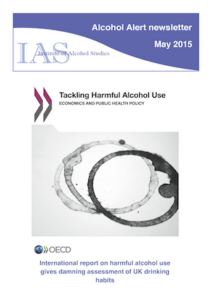In this month’s alert
Editorial – May 2015
Welcome to the May edition of Alcohol Alert, the Institute of Alcohol Studies newsletter, covering the latest updates on UK alcohol policy matters.
In this issue, the OECD’s first report on harmful alcohol use finds Brits’ drinking levels above average since 1995; Action on Alcohol Week in Ireland focusses on the issue of the consumption of alcohol among Irish women; and public health experts await the alcohol policy decisions of a new Conservative government following the Party’s victory in the recent UK General Election. Other articles include: supermarket beer drinkers rank price above ABV according to poll; Guinness tweet escapes ad ban; and European Parliament passes resolution for a new EU Alcohol Strategy.
Please click on the article titles to read them. We hope you enjoy this edition.
OECD report gives damning assessment of UK drinking habits
First major OECD report on harmful alcohol use finds Brits’ drinking levels above average since 1995
The UK consumes more alcohol than the average OECD member country, and has done so for 20 years, according to a study published by the Organisation for Economic Co-operation and Development (OECD).
The Tackling Harmful Alcohol Use: Economics and Public Health Policy report examines the health and economic impact of policies, such as tax, regulation, education and health care, on dangerous drinking in OECD nations.
Its analysis of trends in alcohol consumption of OECD countries found that while average annual consumption is the equivalent of 9.5 litres of pure alcohol per capita (down by 2.5%, on average, during the past 20 years), UK alcohol consumption increased over the same period of time, reaching an estimated average of 10.6 litres annually in 2011. This raises questions for how best the country can tackle the inevitable health and social impacts of widespread harmful and hazardous drinking.
England’s country profile reads as follows:
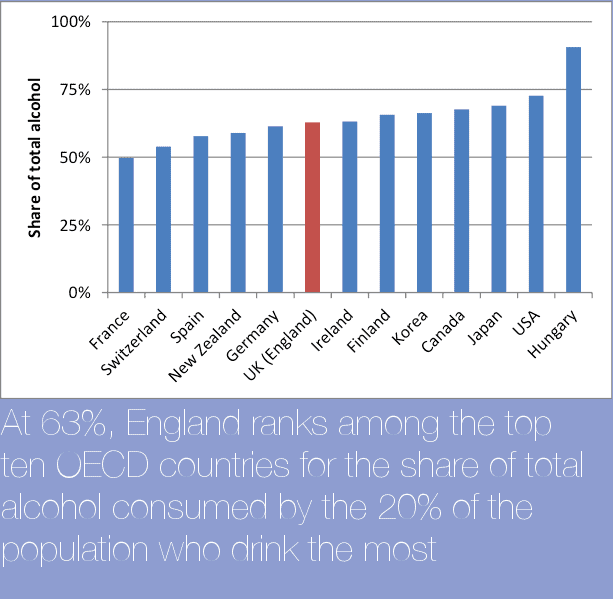
1. Levels of alcohol consumption in the United Kingdom are above the OECD average and increased during the last 30 years. In 2011, an average of 10.6 litres of pure alcohol per capita was consumed in the United Kingdom, compared with an estimate of 9.5 litres in the OECD.
2. Initiation into alcohol drinking happens at increasingly early ages. In the United Kingdom, the proportion of 15 year olds who have experienced alcohol increased from 71% in 2002 to 75% in 2010.
3. The distribution of alcohol drinking is heavily concentrated. In England, the heaviest-drinking 20% of the population drink almost 63% of all alcohol.
4. Large socio-economic disparities in hazardous drinking rates exist in both men and women. In England, both men and women with high education are more likely to be hazardous drinkers than their less educated counterparts (illustrated, right).
5. Compared with other countries in the OECD area, the United Kingdom has relatively high levels of taxation for all types of alcoholic beverages. The blood alcohol concentration (BAC) limit for drivers is 0.08%, the highest in OECD countries, although Scotland lowered the limit to 0.05% in 2014 (the majority of OECD countries enforce a BAC limit of 0.05%). The United Kingdom has adopted a wide-range of policies to regulate on- and off-premise sales of alcoholic beverages and promotion of alcohol products, but other legally binding regulations (e.g. on sponsorships, sales promotions and health warnings on alcohol containers) are not applied at the national level.
The results for England tally with several of the key findings of the report:
• Average annual consumption in OECD countries is the equivalent of 9.1 litres of pure alcohol per capita (down by 2.5%, on average, during the past 20 years).
• The majority of alcohol is drunk by the heaviest-drinking 20% of the population in the countries examined.
• Rates of hazardous drinking (a weekly amount of pure alcohol of 140 grams or more for women, and 210 grams or more for men) and heavy episodic drinking (“binge drinking”, defined as five to eight drinks in one session depending on the country) in young people, especially women, have increased in many OECD countries.
• The proportion of children aged 15 and under who have not yet drunk alcohol shrank from 44% to 30% of boys and from 50% to 31% of girls during the 2000s. the proportion of children who have experienced drunkenness increased from 30% to 43% (boys) and from 26% to 41% (girls) in the same period.
• People who are better educated and of higher socioeconomic status (SES) are more likely to drink alcohol than others.
• Less educated and lower SES men, as well as more educated and higher SES women, are more likely to indulge in risky drinking. The drinking behaviours of young, better educated, and higher socioeconomic status women are converging to those of men.
The paper concludes that governments seeking to tackle binge drinking and other types of alcohol abuse can use a range of policies that have proven to be effective, including counselling heavy drinkers, raising prices, increasing the regulation of the marketing of alcoholic drinks and stepping up enforcement of drinking and driving laws.
“The cost to society and the economy of excessive alcohol consumption around the world is massive, especially in OECD countries,” said OECD Secretary-General Angel Gurría, launching the report in Paris. ”This report provides clear evidence that even expensive alcohol prevention policies are cost-effective in the long run and underlines the need for urgent action by governments.”
OECD experts Franco Sassi and Mark Pearson, who helped contribute to the making of the report, presented the findings at a press conference in London, while Angel Gurría held a press conference in Paris simultaneously.
Watch video Alcohol: tackling heavy cost of harmful drinking for a summary of the report’s findings.
Action on Alcohol Week in Ireland: Women drink as much as men
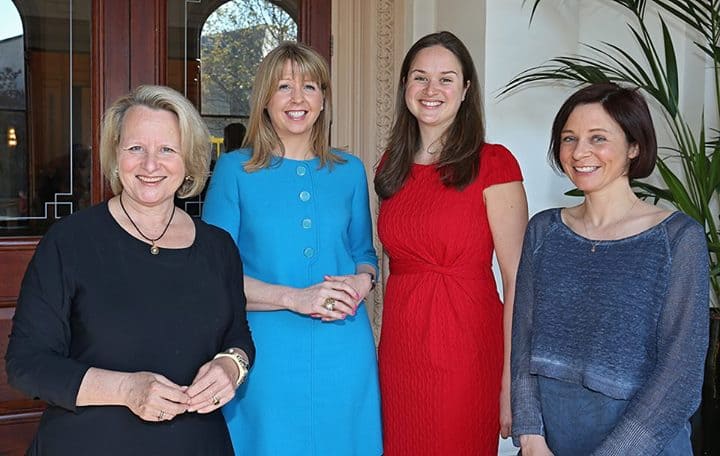
Conference on female consumption in Ireland headlines Action on Alcohol Week; Irish Health Minister also announces alcohol bill set for summer 2015
Irish women now drink as much as their male counterparts, Alcohol Action Ireland CEO Suzanne Costello told her audience at the Girls, Women and Alcohol: The changing nature of female alcohol consumption in Ireland conference held in Dublin on 21 April.
The conference was the standout event of Action on Alcohol Week, which began on April 20th. This initiative was coordinated by a steering group of representatives from the Alcohol Forum, Alcohol Action Ireland, Drugs.ie, and the Royal College of Physicians Ireland who are concerned about and working to reduce alcohol-related harm in Ireland.
Figures on female drinking in Ireland mentioned during the conference also highlighted the consumption patterns of young women. Since 1995 teenage girls are out-boozing boys and 4 out of 10 women report harmful drinking patterns – meaning their drinking is already harming their physical and / or mental health.
Between 1995 and 2004, there was a 29% increase in teenage girls being admitted to hospital for alcohol-related conditions, compared with a 9% increase in teenage boys.
Middle-aged women are developing alcohol-related ill health and dying more prematurely than their male counterparts, with professional women drinking significantly more than non-professionals.
Leading the conference, Suzanne Costello said: “In recent decades, Irish women, particularly younger women, have begun to drink more alcohol, more often.
“The shift we have seen in the nature of women’s drinking in Ireland has been influenced by a number of factors, but the main one is undoubtedly how heavily targeted they have become by alcohol marketing and advertising, including the development of many products – often high in alcohol content – specifically for the ‘female market’.”
The notion that female drinking in Ireland has been driven by the aggressive marketing of the alcohol industry was echoed by other speakers (pictured), including Ann Dowsett Johnston, Canadian author of best-seller Drink: The Intimate Relationship Between Women and Alcohol, sold in the UK and Ireland as Drink: The Deadly Relationship Between Women and Alcohol.
On profit and marketing, she says: “There was an entire gender underperforming. The invention of alcopops was aimed to steer teenage girls away from beer towards spirits. The profits of Smirnoff went up. Today in Canada and the US, there is Cupcake Wine, Girls’ Night Out wine, MommyJuice wine, berry flavoured vodkas. These are not marketed at men.”
“Socially, we are equal, but metabolically and hormonally we are not,” continued Johnston.
“There has been an overall 30% increase in liver disease in the past decade, and 15% of all breast cancers are linked to alcohol consumption.
“But alcohol is our favourite drug and we don’t want to look at that. This is a public health crisis, yet we have very fuzzy values around women and drinking. You can keep your masculinity and have too much to drink – but not your femininity.”
Johnston offered three reasons for why Irish women tended to drink more alcohol today than in previous generations.
“First, there is heavy pitching of alcohol to women. Second, it’s the modern woman’s steroid, enabling her to do the heavy lifting. We come home from work, and we start another day’s work. Emancipation has resulted in complex lives.
“And thirdly, we use alcohol to self-medicate. It’s a lot easier to pop a cork than to seek help for depression and anxiety – which we are more prone to suffer from than men. Alcohol is too cheap, too accessible, and too heavily marketed.”
This is where another conference speaker, Lucy Rocca, has first-hand experience. As founder of Soberistas – a peer support online resource for women with alcohol dependency issues – she found that the women who use the site are largely college educated, professional people, mums, and mostly wine drinkers.
She notes: “In the last twenty years, the wine manufacturers have really targeted the female market, telling us it’s an almost harmless drink that works well as a stress reliever, a social lubricant, and something to add a touch of glamour and pizazz to an evening.”
The speech delivered by Katherine Brown, Director of The Institute of Alcohol Studies, focussed on industry tactics, bringing to the audience’s attention the conflict of interest in drinks companies’ funding of public health campaigns while being the main drivers of alcohol consumption.
“Interventions that rely solely on changing individual behaviours simply won’t work while we are surrounded by promotions and cheap offers that normalise everyday and excessive drinking” she said.
“The alcohol industry has worked for years to make alcohol products appealing to women, bombarding us with messages that glamorise drinking while ignoring all the negative health effects such as breast cancer. It’s extremely important that women are told about these risks so that they can be empowered to make informed decisions about their drinking.”
Brown also spoke on the theme of alcohol sponsorship of sport and its effects on children’s drinking habits in later life at a briefing connected to the main event. She noted that it acted as “a gateway to children’s bedroom doors”, a comment repeated by Senator Jillian van Turnhout at a subsequent Health Committee hearing (23 April).
Irish Public Health (Alcohol) Bill set for summer 2015
Sponsorship of sport was an important policy detail for Leo Varadkar TD as he addressed the 3rd National Alcohol Forum Conference entitled The Best Available Evidence: Supporting the implementation of local solutions to reduce alcohol consumption and alcohol harms, held the following day (22 April) at Croke Park.
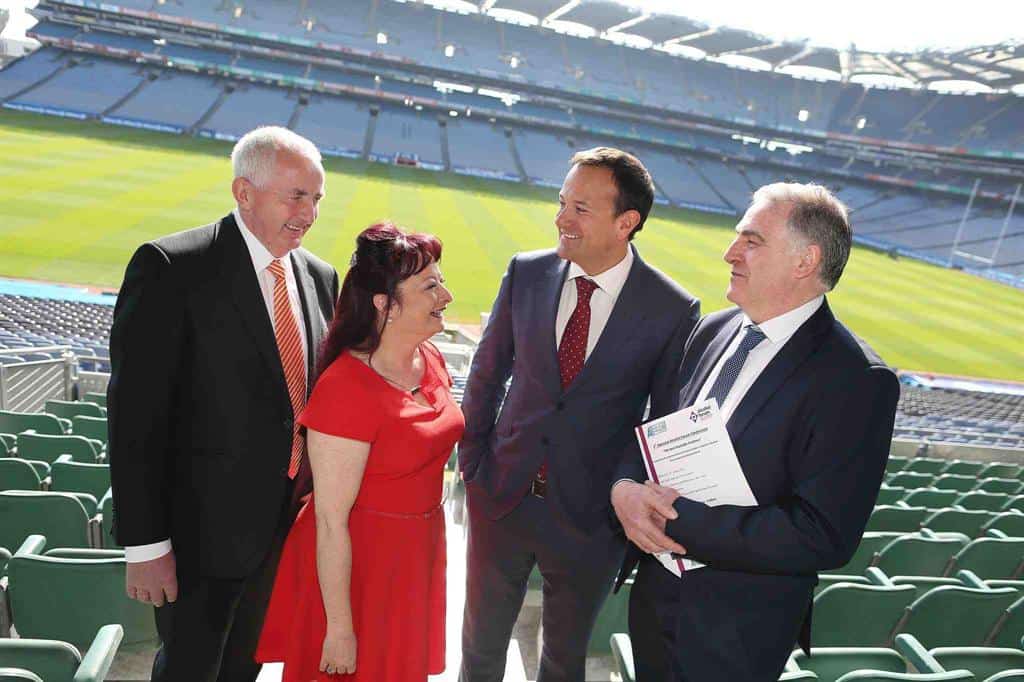 The Irish Health Minister confirmed that the Public Health (Alcohol) Bill will be published this summer with a view to being made law by the end of 2015.
The Irish Health Minister confirmed that the Public Health (Alcohol) Bill will be published this summer with a view to being made law by the end of 2015.
TD Leo Varadkar’s announcement comes as new figures show that the Irish drank 11 litres of alcohol per person last year, up from 10.6 litres in 2013, a possible reflection of Ireland’s economic recovery.
The bill will introduce minimum unit pricing for alcohol, and regulate alcohol advertising and sponsorship targeted at young people, including a broadcast watershed and a pledge to review alcohol sponsorship of sports events in 3 years’ time.
“This legislation has been bandied around for 3–4 years and it wasn’t possible to get agreement on this. We’re in year 4 of the parliament and I want to get good stuff done,” he said.
Leo Varadkar (pictured; second from right) also announced his intention to use minimum unit pricing to help reduce annual consumption in Ireland to the OECD average of 9.1 litres per person by 2020.
He said: “Despite Ireland having relatively high excise duty rates, the price of alcohol remains affordable, particularly in supermarkets.
“A woman can reach her low risk weekly drinking limit for just €6.30, while a man can reach this weekly limit for less than €10.”
Mr Varadkar said minimum unit pricing would be based on the number of grammes of alcohol in a drink but no price had been agreed yet: “It needs to be low enough so that it eliminates very cheap alcohol but not so high that it affects the price of a glass of wine in the pizzeria.”
However, he also pointed out that it could be blocked by the European Court of Justice on the grounds that it impedes free trade.
Responding to calls by experts at the conference to ban drinks sponsorship of sport, Mr Varadkar said that it will happen in the next 5 to 10 years. The current proposal will instead put curbs on marketing and advertising of alcohol, some of which is extraordinary, he insisted.
However, disappointment was expressed at the failure to propose an outright ban on sports sponsorship by drinks companies. Independent TD Séamus Healy said it was time for the Government to “grasp the nettle” and end the relationship between alcohol and sports sponsorship permanently.
Stop Out of Control Drinking scheme under fire over its position on Irish Public Health Bill
Campaign falls short of full endorsement; industry sponsors silent on minimum unit pricing
The anti-alcohol campaign Stop Out of Control Drinking has failed to publicly back the entirety of the Irish Government’s Public Health (Alcohol) Bill 2015, revealed earlier this year.
The Bill outlines a range of measures to tackle binge drinking, including an advertising watershed and strict regulations on separating alcohol from other products in retail outlets. However, although a spokesperson for Stop Out of Control Drinking said the campaign’s board supports the general scheme of the Bill, plans to introduce minimum unit pricing, which could see the price of a can of beer rise to €2.20 and a bottle of wine to €8.80, have been ignored by the campaign’s funders, Diageo. As a member of the Scotch Whisky Association, the drinks firm is involved in a court case challenging the legality of the Scottish government’s plans to introduce minimum unit pricing as law.
The Alcohol Beverage Federation of Ireland (ABFI) has also remained quiet over the question of whether to support minimum unit pricing in order to tackle the sale of cheap alcohol, instead suggesting that “the best and quickest way to do this is by reintroduction of a ban on below cost selling of alcohol”.
But the likes of Alcohol Action Ireland and the National Off-Licence Association (NOFFLA), who openly support the move, have criticised the campaign’s failure to do so as well. Alcohol Action Ireland CEO Suzanne Costello said: “Any initiative which doesn’t wholly support the bill can’t really be seen as worthwhile.
She added: “We don’t feel that the alcohol industry has any role in the formulation of alcohol policy”.
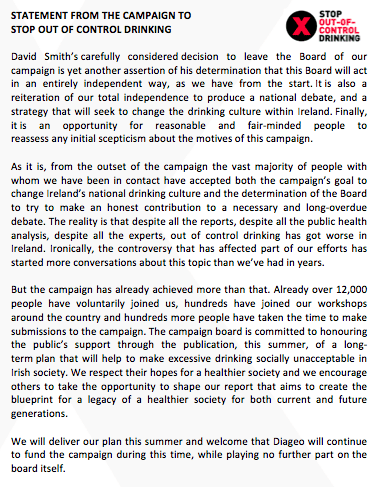 Bad publicity
Bad publicity
This spat marks the latest controversy in a long-running dispute between Diageo and public health experts over the Stop Out of Control Drinking campaign.
The scheme has had problems right from its high-profile launch at the start of the year, when it was discovered that it had accepted €1m in funding from the drinks firm.
Stop Out Of Control Drinking campaign chair Fergus Finlay – who is also CEO of children’s charity Barnados – defended the anti-binge drinking campaign’s involvement with the makers of popular Irish drink Guinness on Irish national television.
Speaking on RTÉ’s Prime Time in March, Mr Finlay denied there was a conflict of interest between Diageo’s funding of the Stop Out Of Control Drinking campaign and the alcohol multinational’s participation in attempts to stop the addition of a ban on sports sponsorship to the Alcohol Bill. When pressed on whether he thought Diageo’s opposition to the measure hampered the campaign’s anti-binge drinking message, he remarked: “I had discussions at the very start with Diageo; I said we’ll do this campaign, on the basis of an absolute guarantee of independence and no interference… I’m not going to apologise to anybody for spending as much of Diageo’s money as I possibly can with my colleagues to try and reduce the harmful effects of alcohol abuse.”
But Senator Jillian Van Turnout, member of the Oireachtas Committee on Health and Children, challenged the intentions of the campaign’s sole funder. She said: “My difficulty with the campaign is that the credibility, the reputations of the organisation [Diageo] are a smokescreen. And I really believe, we, as civil society, should be getting behind public health experts.”
The issue of funding has also been raised at meetings; one of the members, entrepreneur Gavin Duffy, admitted to the Irish Independent that Diageo’s sponsorship of the campaign had created a “credibility gap” within the group itself.
The Stop Out of Control Drinking campaign has also lost high-profile members from its board, most notably TV doctor Ciara Kelly, who stepped down citing “time constraints”, and Diageo Country Manager for Ireland David Smith, as publicised by a statement to the press towards the end of March (illustrated).
Health Minister Leo Varadkar welcomed the move, saying: “I don’t think it is appropriate that the drinks industry should be actively involved in campaigns around public health for the obvious reasons.”
An open letter signed by the likes of comedian Des Bishop, folk singer Christy Moore and TD Róisín Shortall went further in its criticisms, accusing the campaign group of continuing to have ties to Diageo through funding.
The letter also questions the independence of board as it continues to use one-time tobacco lobbyist Goddard Global UK as secretariat.
What does the future hold for alcohol policy under a Tory government?
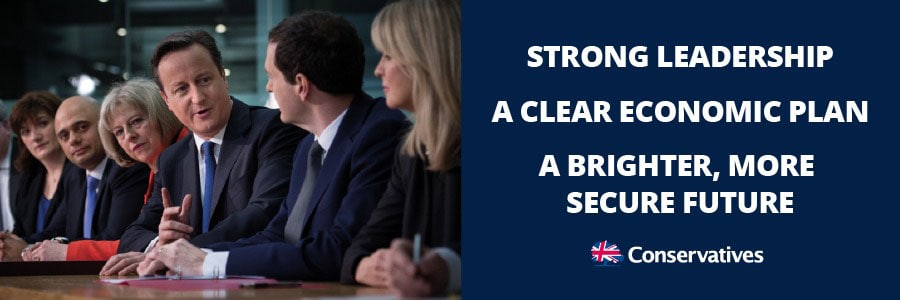
Party quiet on public health measures including minimum pricing in manifesto
Alcohol policy faces an uncertain future under a newly elected Conservative government as it decides how it will run the country for the next five years.
Despite having a half a dozen mentions of the word “alcohol” itself, the Party’s manifesto for the 2015 UK General Election failed to detail specific evidence-based alcohol policies that it might implement, such as minimum unit pricing, to prevent alcohol related health and social harm, that currently costs the UK economy more than £21 billion each year. Instead the document focussed on its commitment to dealing with alcohol dependency and addiction as some of the root causes of the UK’s social and health problems, crime, and poverty. The sole targeted aim mentioned in the manifesto promised to “make sobriety orders available to all courts in England and Wales, enforced through new alcohol monitoring tags”. This is despite the fact that the pilot schemes are yet to be concluded.
According to Alcohol Policy UK, the Conservatives’ 2015 manifesto adopts a more cautious tone towards alcohol policy compared with five years ago, when the Party set out plans to introduce the so called ‘below cost ban’, as well as pledges to ‘overhaul’ the licensing regime.
However the Morning Advertiser has already reported that the Tories have pledged licensing fees for the majority of pubs would be frozen and reviewing business rates to support small firms. This hints at a continuation of the business-friendly approach that the Party has taken since it formed a Coalition government with the Liberal Democrats in 2010.
Track record
In this time, the Conservative Party’s record on alcohol policy has left little for public health advocates to cheer. Its flagship initiative, the controversial Responsibility Deal (PHRD), encouraged partnership with the industry in formulating health policy. But many public health groups left the PHRD on the basis that business interests appeared to take priority over public health goals, with no evidence to suggest that industry pledges had led to reductions in rates of alcohol harm.
However, the former Coalition government continued to work with the alcohol industry on this self-regulatory initiative, while successive Public Health ministers have held meetings with industry representatives lobbying for fiscal policy changes that would undermine long-term alcohol policy on health, including the premature abolition of the alcohol duty escalator by Chancellor George Osborne in the 2014 Budget.
And although the government introduced a below-cost sales ban on alcohol in the previous Parliament, some health groups see that measure as inferior to the much-contested minimum unit pricing. In the 2012 Alcohol Strategy, Prime Minister David Cameron wrote: “When beer is cheaper than water, it’s just too easy for people to get drunk on cheap alcohol at home before they even set foot in the pub. So we are going to introduce a new minimum unit price.”
However, following a lengthy consultation process, the Home Office decided not to introduce minimum unit pricing for the time being, reckoning that it “[did] not yet have enough concrete evidence that its introduction would be effective in reducing harms associated with problem drinking… without penalising people who drink responsibly.” This is despite commissioning a study from the University of Sheffield that showed how the policy would, at the mooted 45p per unit, be up to 50 times more effective than a below cost selling ban, and have a minimal impact on moderate drinkers.
Fast-forward to today, and the Conservative Party appears still reluctant to mention the minimum unit pricing to the UK electorate. Speculating on the possibilities for introducing the measure, Alcohol Policy UK’s article notes that: “with minimum pricing hardly a vote winner, early in the parliamentary term is when less popular policies may be more likely to be implemented.
“Scotland’s long running MUP battle is however still being dragged through the European courts, so any other Government is unlikely to attempt it before the verdict. Least of all the Tories one would assume, given their infamous minimum pricing u-turn.”
The Conservative Party as the leading partner of the Coalition government has garnered a reputation for prioritising business interests by lowering alcohol taxes while
encouraging light-touch regulation for other policy areas such as
advertising, which has posed serious problems for public health
organisations at both national and local level.
Given this track record, it remains to be seen how a fully Conservative government will be able to reconcile its ambition to reduce rates of premature avoidable mortality, reverse the increasing burdens on the NHS and emergency services, and grow the economy from its current precarious position over the next five years, without pursuing head-on evidence-based alcohol policies such as minimum unit pricing.
Movie drinking linked to alcohol-related problems in teens
UK study finds exposure to alcohol use in films associated with higher risk of alcohol use and alcohol-related problems among adolescents
Findings produced by University of Bristol researchers confirm a link between adolescent alcohol use in the UK and exposure to alcohol use in films.
Published online in Pediatrics, the study Alcohol Use in Films and Adolescent Alcohol Use revealed that adolescents with the highest exposure to alcohol use in films were 1.2 times more likely to have tried alcohol compared with those least exposed and 1.7 times more likely to binge drink. They were also at least twice as likely to drink weekly and to have alcohol-related problems than those least exposed.
The cross-sectional study adds to previously published literature which has hinted at a relationship between both factors. However, the authors claim that this study stands apart for being the first to adjust for the many early childhood exposures and characteristics that might affect life course trajectories and confound the movie alcohol exposure-youth alcohol consumption association. Adjusting for various factors allows the authors to draw a clearer picture from the data.
Method
5,163 15-year-olds from the Avon Longitudinal Study of Parents and Children in the United Kingdom were asked whether they had seen 50 randomly selected films from a list of 366 popular contemporary films. The amount of time alcohol use was depicted in each film was recorded in seconds and total exposure was the sum of durations in each film the adolescent had seen.
Participants were then asked about alcohol use, categorised as 4 potential outcomes: 1) alcohol onset; 2) current alcohol use; 3) binge drinking in the last 2 years; and 4) alcohol leading to problems in last two years.
Data accounting for both confounding and mediating variables were also collected, namely about parental alcohol use and how many of the participant’s friends drank alcohol during the last year, respectively.
Adjustment for the confounders were modelled as follows:
Model 1: age and gender
Model 2: age, gender and social factors
Model 3: age, gender, and early family influences
Model 4: age, gender, and current family influences
Model 5: age, gender, social factors, and all family influences
Model 6: Model 5 plus behavioural factors
Model 7: Model 6 plus current factors (smoking, peer alcohol) adjusting for mediators
Results
The proportion of adolescents who had tried alcohol was 85.7%. Just over a fifth (21.2%) currently consumed at least one drink a week. Nearly half (46.6%) were binge drinkers, and 42.6% had experienced at least one drink-related problem.
Data on the likelihood of alcohol use in relation to film exposure was split into several categories: onset alcohol use or initiation (ever had a whole drink) and weekly drinking (currently drink at least weekly) for one table; binge drinking (in the last two years) and alcohol-related problems (alcohol leading to at least one problem in the last two years) for another, all ranging in duration of exposure to alcohol use in films watched.
After adjusting for age, gender, social factors, all family influences, and behavioural factors (Model 6), results showed that there was a 1.2 times increased risk of alcohol onset for the highest exposure and a 2.4-fold increased risk of drinking weekly compared with those least exposed (illustrated below; Association between film exposure and alcohol outcomes). The risk of binge drinking was 1.7 times higher and that of alcohol-related problems in the previous year doubled (Association between film exposure and adverse alcohol outcomes).
The authors wrote that, contrary to previous studies, risk factors such as familial alcohol use, parental monitoring, and sensation seeking did not alter associations between alcohol use in films and adolescent alcohol use. However, mediating factors such as peer alcohol use and smoking behaviours did influence teenage consumption.
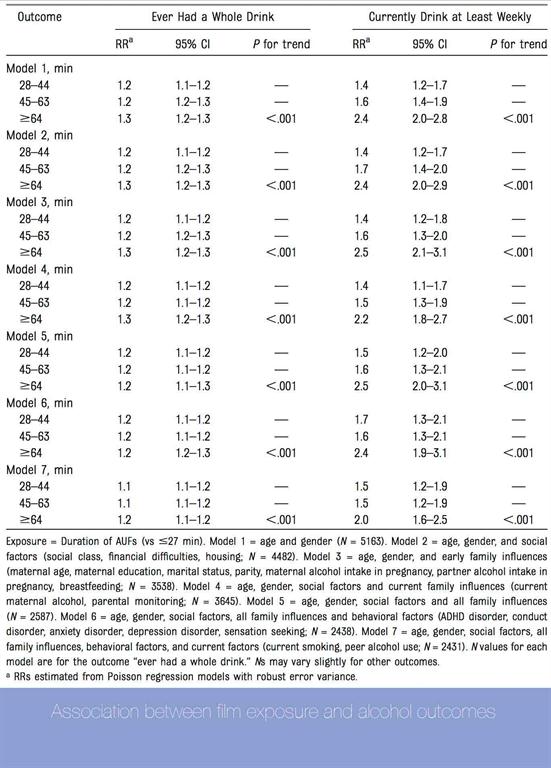
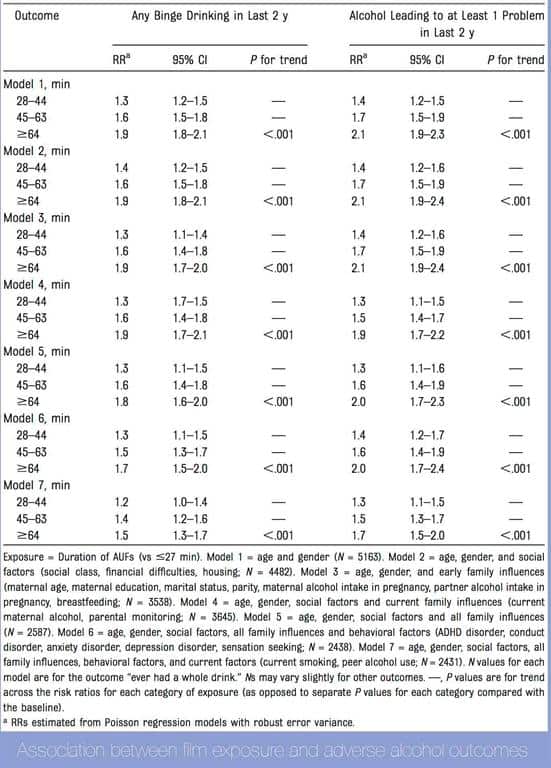
Limitations
The authors of the study acknowledged their uncertainty over whether adolescent alcohol use was sanctioned by parents, as well as the impact of parental viewing restrictions on their children’s exposure to the films.
They also wrote that because data collected (i.e. exposure to alcohol use in films, drinking consumption, peers’ alcohol use, individual own smoking behaviours) were cross-sectional – that is, a snapshot observation of participants’ behaviour – they could not determine causality from the results.
Conclusion and recommendations
The report concluded: “Exposure to alcohol use in films is associated with higher risk of alcohol use and alcohol-related problems in UK adolescents.”
Given the findings of the University of Bristol study and those before it, the authors suggested that more attention be paid to the classification of films depicting alcohol use.
They wrote: “An adult rating for alcohol use would result in the removal of alcohol use from films intended for the adolescent market and also reduce adolescent exposure via adult-rated films.
“Our findings support the argument that a review of film-rating categories and alcohol ratings for all films may help reduce problem-related alcohol consumption in young people.”
Poll: one-in-five women drink while pregnant
Survey also finds half of drinkers do not believe getting drunk will do any harm to their unborn baby
A poll has found one in five women drink alcohol while expecting, with almost half of these mothers saying they didn’t think becoming intoxicated would do any damage to their unborn baby.
Drinking while pregnant came third in a top five list of “forbidden” pregnancy behaviours carried by expectant mothers. Other actions included having more caffeine than the recommended amount (44%) and smoking (10%).
When asked why they carried out these behaviours while carrying a baby, almost half said they ‘did not think it would harm my baby in any way’.
The poll, carried out by VoucherCodesPro, asked 2,184 British women aged 18 years and over questions about their behaviours and attitudes.
All respondents had given birth to a baby within the past 18 months and were quizzed on their pregnancy and their behaviour during that time.
Chief Medical Officer guidelines state: “Women who are pregnant or trying to conceive should avoid alcohol altogether.”
“Good week” Guinness tweet escapes ad ban
Diageo-owned beer brand passes ASA test following a complaint from Alcohol Concern
Alcohol Concern raised concerns over a tweet on the Guinness Twitter feed that stated “A good week starts here”, featuring a black and white photo of the brewery gates. The charity believed the tweet implied the week would be improved by drinking alcohol, alleging the ad was irresponsible and in breach of the code.
A good week starts here. pic.twitter.com/vY2WXF2sUT
— Guinness Ireland (@GuinnessIreland) February 2, 2015
Diageo responded that the tweet referred to a good week of work brewing Guinness, claiming that the brewery gates were iconic and would be interpreted by consumers as the place where Guinness is manufactured, not consumed.
The drinks giant also said that the tweet formed part of a bigger Guinness campaign which focused on telling the stories of the people behind the beer, such as the stories of employees at the brewery, emphasising that the tweet did not feature the alcoholic product itself, and did not refer to the consumption of alcohol.
The Advertising Standards Authority (ASA) rejected Alcohol Concern’s claim, noting that the disputed tweet did not feature alcoholic products, consumption of alcohol, or a social event. In its judgment, the regulator stated that it did not believe the tweet “equated to a statement about the effects of alcohol on a social event or on someone’s mood, or as an encouragement to drink irresponsibly.
“On that basis, we did not consider that the ad implied that someone’s week would be improved by the consumption of alcohol and we concluded that the ad was not irresponsible or in breach of the code.”
The ASA therefore cleared the ad of breaching the CAP Code rules on responsible advertising and alcohol, and said no further action was necessary.
Poll: price top factor for supermarket beer drinkers
Market research reveals drinking habits determined by price, not lower alcohol content
Four-in-ten people rate price as most important factor when buying beer in supermarket, according to a consumer survey, as reported in The Grocer.
Nielsen’s State of the Nation report, which polled 7,136 people in January 2015, asked respondents which two factors from a list were most important to them when buying beer in a supermarket. 39.3% of panellists said price was most important, and 30.4% said brand. Just 4.8% said alcohol content.
Furthermore, almost two-thirds of respondents who drank alcohol (49.2% of all panellists surveyed) said they were not looking to reduce alcohol intake by drinking low-ABV products. Just 1.8% said that they were.
Among those that were, the most common approach was drinking less frequently (20.6%), followed by drinking less per occasion (7.5%).
The findings will be a blow to the efforts of suppliers that have rolled out lower alcohol drinks in recent years, suggesting consumer demand for such products hasn’t materialised.
“Lower ABV products are being driven by manufacturers and retailers rather than consumers,” said Nielsen client team leader Natasha Kendall. “If we look at the size and performance of lower ABV wines, beers and cider then these categories are still small and not performing especially well.”
Sales of no and low alcohol wine were flat last year at £37.3m – less than 1% of the £5.5bn still wine category [Nielsen 52 w/e 28 March 2015]. Sales of alcohol free and lighter beer, meanwhile, fell 7.4% to £75.6m and accounted for 2% of the beer market’s £3.8bn total.
Lines blurred as industry mixes sport and alcohol cocktail
Alcohol companies are finding new and sophisticated ways to use the power of social media to pitch drinking as pivotal to the sporting experience
Findings presented at the World Social Marketing Conference in Sydney demonstrate how social media has now become an integral part of alcohol promotion – giving the industry the ability to reach millions of consumers and aggressively target young drinkers.
The Merging sport and drinking cultures through social media study, funded by the Foundation for Alcohol Research and Education (FARE) and undertaken by RMIT University, found the alcohol industry cleverly timed its posts to tie in with professional sporting events to encourage consumption.
The study analysed Facebook, Twitter and YouTube content around the Australian Football League, National Rugby League and Australian Cricket 2013-14 seasons.
It found it was common for the industry to use social media to target consumers with product messages themed around sporting identity, culture and camaraderie.
RMIT’s Associate Professor Kate Westberg, one of the authors of the study, said the industry’s social media strategies were carefully developed to go beyond just promoting their product.
“The ultimate goal appears to be to merge the drinking culture with sport culture,” she said.
“They seek to normalise consumption by using social media to present drinking as an integral part of the sport experience whether spectatorship, celebration or commiseration.”
Sport provided a powerful marketing platform for the alcohol industry – particularly when combined with the collaborative and immersive nature of social media. The study found that brands (e.g. Carlton Draught, Victoria Bitter, XXXX Gold) use a range of media, such as smartphone apps, push notifications, trivia and tipping competitions, celebrity endorsements, promotional merchandise, videos, memes and co-created content linked to sport to engage with consumers and gain access to their extended social networks.
Sport-linked social media strategies featuring a ‘call to action’ encouraging competition, collaboration, celebration and consumption were commonly used. “The ‘calls to action’ aim to stimulate consumers to actively engage with the brand, rather than passively receiving brand messages, as is the case with conventional advertising,” Associate Professor Westberg said.
FARE Chief Executive Michael Thorn says the study offers further insights into the concerning ways in which the alcohol industry is able to co-opt the sporting culture in order to shape the drinking culture and manipulate consumers.
“Alcohol’s marketing and sponsorship linkages are most apparent on our TV screens, but in fact, are just as insidious on social media where the alcohol industry has become increasingly sophisticated in the ways it ties its products to professional sport. Of concern, the online space is even less regulated than traditional media. Self-regulation isn’t working, it isn’t protecting children from harmful alcohol advertising and those harms will continue until such time that the Commonwealth Government steps in,” Mr Thorn said.
Supreme Court foetal alcohol damage appeal rejected
Council compensation claim suffers final blow
A child born with foetal alcohol syndrome has been refused permission to take her case for criminal injuries compensation to the UK Supreme Court.
The 7-year-old girl, whose mother drank excessively while pregnant, was born with severe brain damage.
The case was originally brought by a council in north-west England – which cannot be named for legal reasons – to the Criminal Injuries Compensation Authority on the girl’s behalf on the basis that the she was the victim of crime because her mother had administered a noxious substance to her.
However, the Court of Appeal ruled in December that the girl, now in care, was not legally entitled to compensation.
Now permission to appeal to the Supreme Court has also been refused because an arguable point of law was not raised, closing the door on the only legal option left open to the council.
The guidelines laid down by the Chief Medical Officer for England & Wales recommend that pregnant women should not drink at all – adding that those who choose to have a drink should have no more than two units of alcohol once or twice a week. Please view the Foetal Alcohol Spectrum Disorders (FASD) Trust website for more information on the dangers of FASD.
CAMRA votes to end LNLs
Real ale group passes motion at AGM
As reported in The Morning Advertiser, members of the Campaign for Real Ale (CAMRA) have voted for the organisation to start campaigning for the abolition of the late-night levy (LNL) at their annual general meeting in April.
The LNL motion notes that a growing number of local authorities are introducing the fee and calls for CAMRA to provide resources and data to its branches that can be used in discussions with local councils.
A LNL can be imposed on pubs and bars that operate after midnight by local authorities. It has so far been introduced by 7 seven councils.
The fee charged depends on the rateable value of the affected premises, and ranges from £299 and £4,400 per year.
The motion now must be ratified by CAMRA’s National Executive to be formally adopted as policy.
A spokesman for the real ale group said: “LNLs can punish well-run community pubs, which do not contribute to anti-social behaviour but are forced to pay to police noise and disorder caused by late-night bars and nightclubs.
“CAMRA’s National Executive will consider motions passed at conference and put a strategy in place to help local CAMRA branches get more information about late-night levies in their areas and campaign effectively for well-run pubs to be treated fairly, rather than penalised by this blanket measure.
Court ruling: Reducing the Strength scheme still valid
Senior magistrate in so-called “landmark case” calls for consultation between interested parties over police-led initiatives
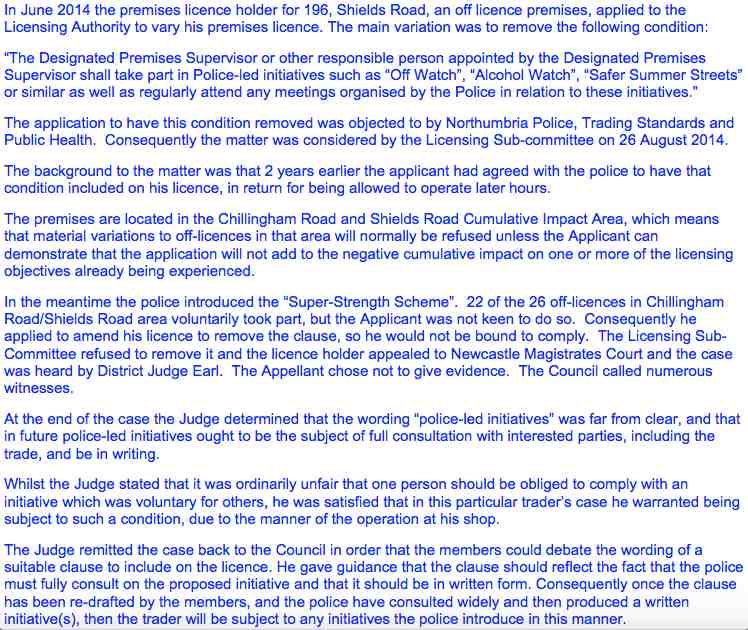 Newcastle City Council (NCC) has produced a statement (pictured) clarifying the sequence of events around a legal dispute with the off-licence Lifestyle Express, which shows that the owner was denied permission to relax the restrictions on his licence to sell high-strength alcohol.
Newcastle City Council (NCC) has produced a statement (pictured) clarifying the sequence of events around a legal dispute with the off-licence Lifestyle Express, which shows that the owner was denied permission to relax the restrictions on his licence to sell high-strength alcohol.
This verdict contradicts an article in Off Licence News (OLN) alleging that retailers could be entitled to compensation from councils over removing high-strength products from their stores.
After his initial application to amend his premises licence was refused, store owner Shabir Mohammed appealed to Newcastle Magistrates Court, claiming that he had lost £280,000 as a result of being forced to implement the Reducing the Strength scheme. The OLN reported the resulting verdict given by District Judge Earl as ruling in favour of Mohammed, heavily criticising the authority’s actions for imposing a condition despite a lack of “direct evidence that the premises was undermining licensing objectives”.
However, the Council’s statement noted that the judge had said he was satisfied that in this particular trader’s case, “he warranted being subject to such a condition, due to the manner of the operation of his shop”, calling Mr Mohammed’s conduct into question. The judge gave guidance that the restrictions placed upon the licence holder be revised, subject to consultation between Northumbria Police, NCC’s Licensing Sub-Committee and other interested parties.
Since its inception in Suffolk in 2011, the Reducing the Strength initiative has come under attack from the industry for encouraging anti-competitive practices. Chair of the All Parliamentary Party Beer Group Andrew Griffiths raised this concern on their behalf in a letter addressed to the Office of Fair Trading (OFT) in 2014, writing that brewers feared the scheme would “distort competition… restrict consumer choice, and would discriminate in favour of other brands and other drinks categories such as wines and spirits.”
However the regulatory body has already backed the idea of developing guidance for local authorities raising awareness of competition considerations ahead of the release of a Local Government Association document issuing advice to retailers released in December 2014.
European Parliament passes resolution for a new EU Alcohol Strategy
European Parliament ratifies resolution that includes calorie labelling of alcoholic drinks
MEPs voted in favour of a Resolution calling on the European Commission (EC) to present a new EU Alcohol Strategy to tackle health harm for 2016-2022. The move came only a week after European Union (EU) Health Ministers meeting in Riga called on the Commission to take action on the health impacts of alcohol.
The resolution tabled was passed during the day’s plenary session in Strasbourg. A last-minute amendment — led by members of the European People’s Party — to limit calorie labelling on alcoholic beverages to just alcopops threatened to derail the resolution, but it was defeated and the resolution was adopted less than an hour after being brought.
Both MEPs and Ministers have recently criticised the EC for failing to update the previous strategy, which expired in 2012. The UK House of Lords EU Committee also criticised the strategy for achieving very little, urging the EU to “focus on measures within its powers, and not rely just on action by Member States, or voluntary commitments from industry.”
The vote sent a clear message to the EC to speed up efforts to introduce a new strategy in order to reduce alcohol-related harm across all Member States. Glenis Willmott, a sponsor of the original resolution, expressed her delight at the passing of the resolution on social media (illustrated).
#EUAlcoholStrategy passed today! Calorie labelling on alcoholic beverages approved . Great result for EU consumers @beuc @WhichUK
— Glenis Willmott MEP (@GlenisWillmott) April 29, 2015
Public health experts also welcomed the resolution, but urged the EU Commission to act swiftly by bringing forward new laws without delay. Royal Society for Public Health (RSPH) CEO Shirley Cramer CBE said: “While we are pleased with [the] outcome, we must keep the spotlight on this issue and apply pressure on the Commission to ensure the measures are followed through as quickly as possible.”
The renewed EU Alcohol Strategy is proposed to come into place by 2016 and run until 2022. It emphasises the importance of better labelling of alcoholic drinks including ingredients and nutritional information with special focus on calories, and the need to raise awareness across the EU of the dangers of drinking during pregnancy and drink driving.
Podcast
Our monthly podcast features interviews with experts from across the sector.
Gambling industry harms and parallels with the alcohol world
Will Prochaska –
Coalition to End Gambling Ads

